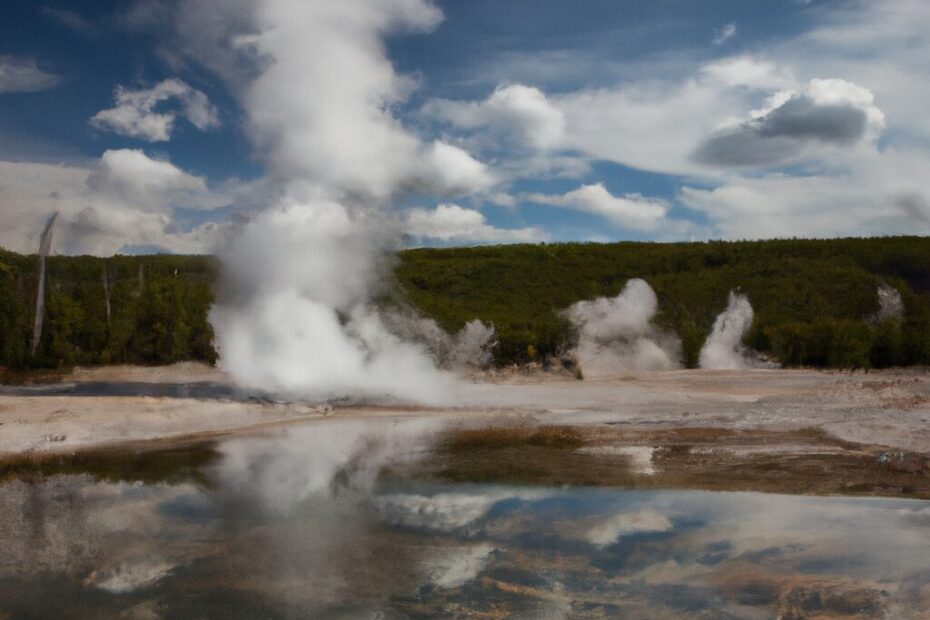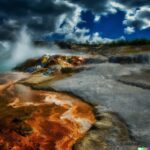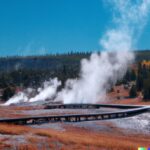Yellowstone National Park is home to some of the most unique and fascinating geothermal features in the world, including its iconic geysers. But what sets Yellowstone’s geysers apart from others around the globe? From their formation to the geothermal activity that fuels them, there is much to learn about these natural wonders.
Join us as we explore the history, location, and future of Yellowstone’s geysers, and discover what makes them a must-see attraction for visitors to the park.
What Makes Yellowstone’s Geysers Unique?
Yellowstone National Park is home to a remarkable array of geysers that are celebrated for their unique characteristics and mesmerizing displays of thermal features created by volcanic activity.
These geysers, such as the iconic Old Faithful, demonstrate the sheer power and beauty of nature’s geological processes. The geothermal wonders found in Yellowstone are a direct result of the underground volcanic activity that shapes the landscape. As underground water is heated by magma, pressure builds until it erupts in the form of these awe-inspiring geysers, releasing a combination of steam, water, and minerals. Surrounding these geysers are vibrant microbial mats and colorful mineral deposits, adding to the surreal beauty of the area.
What is a Geyser?
A geyser is a natural hydrothermal feature that intermittently erupts hot water and steam into the air, showcasing one of nature’s most captivating geological phenomena.
These mesmerizing geothermal wonders are a result of the complex interplay between underground water reservoirs and intense heat generated by magma chambers deep within the Earth’s crust. The process begins with water seeping down through porous rocks and fissures, where it comes into contact with the scorching heat of the Earth’s interior. As the water gets heated to the boiling point, pressure builds up underground until it finally erupts in a spectacular display of steam and water, shooting high into the sky.
Each geyser has its own unique cycle of eruption, making them a fascinating and dynamic feature in the natural world.
How are Geysers Formed?
Geysers are formed through intricate geologic processes that involve the accumulation of underground hot water, leading to the creation of thermal pools and distinctive geological formations.
Over time, as the underground water becomes heated by magma chambers deep within the Earth’s crust, pressure builds up until it eventually erupts through vents in the surface. This sudden release of pressure, combined with the unique shape of the geological formations like narrow channels and underground chambers, results in the spectacular eruptions that we associate with geysers. Thermal pools play a crucial role in this process, acting as repositories for the superheated water until the right conditions trigger a geyser’s eruption.
Where are Yellowstone’s Geysers Located?
Yellowstone’s geysers are prominently situated within the vast expanse of Yellowstone National Park, specifically in hydrothermal areas and thermal basins that offer a glimpse into the geothermal wonders of the region.
These hydrothermal areas and thermal basins are unique geological features that make Yellowstone National Park a hotspot for geothermal activity. With over half of the world’s geysers found within the park boundaries, visitors have the opportunity to witness the power and beauty of natural thermal features up close. The dynamic nature of these geysers, with eruptions that can reach impressive heights, showcases the incredible forces at work beneath the Earth’s surface. The sights and sounds of these hydrothermal wonders create a truly mesmerizing experience for all who venture into the park’s geothermal areas.
What is the History of Yellowstone’s Geysers?
The history of Yellowstone’s geysers is deeply intertwined with the geologic evolution of the region, reflecting the volcanic activity that has shaped this unique landscape over millennia.
These geysers are a result of the intense geological processes that have been ongoing in Yellowstone for millions of years. The volcanic activity underneath the park has led to the formation of a hotspot, resulting in the presence of countless geysers, hot springs, and fumaroles. The release of pressure and heat from the Earth’s mantle through these geothermal features showcases the dynamic and ever-changing nature of the park.
The eruption of the massive Yellowstone supervolcano around 640,000 years ago further solidified the landscape’s volcanic origins, leaving a lasting impact on the geysers we see today.
What is the Geothermal Activity Like in Yellowstone?
Yellowstone’s geothermal activity is a sight to behold, with its diverse range of features including hydrothermal systems that showcase the region’s dynamic and captivating geothermal phenomena.
The hydrothermal systems in Yellowstone function as underground reservoirs of scalding water that periodically erupt in mesmerizing geysers, such as the iconic Old Faithful. These geysers shoot steaming water high into the air, demonstrating the immense pressure and heat beneath the surface.
Yellowstone boasts bubbling hot springs, colorful microbial mats, and mud pots, each offering a unique and enchanting glimpse into the powerful forces at work below the Earth’s crust. The combination of these diverse geothermal features creates a landscape that is not only visually stunning but also scientifically significant.
What Other Geothermal Features Can Be Found in Yellowstone?
Apart from geysers, Yellowstone National Park boasts a plethora of other geothermal features that encompass a wide array of geologic phenomena, providing visitors with enchanting thermal attractions to explore.
These thermal wonders include hot springs, mud pots, fumaroles, and travertine terraces, each offering a unique and mesmerizing sight for park visitors.
Hot springs, with their vibrant colors and soothing warmth, showcase the diverse microbial life thriving in extreme environments.
Mud pots exhibit bubbling mud pools created by interactions between water and hot rock, forming a captivating sight of boiling mud.
Fumaroles, characterized by steam vents emitting sulfurous gases, paint an otherworldly landscape.
The travertine terraces, like those at Mammoth Hot Springs, display stunning mineral formations created by dissolved limestone deposits.
What Makes Yellowstone’s Geysers Different from Other Geysers?
Yellowstone’s geysers stand out from others around the world due to their unique landscapes and the presence of distinctive geothermal vents that contribute to their unparalleled beauty and geological significance.
The interplay between these geothermal vents and the surrounding landscape at Yellowstone National Park creates a dynamic environment where the geysers thrive. The vivid colors of the mineral-rich waters, the diverse microbial life that thrives in these extreme conditions, and the ever-changing terraces and pools all add to the allure of Yellowstone’s geysers. These geothermal features are not only visually stunning but also serve as valuable indicators of the geologic activity that lies beneath the earth’s surface, making them essential in understanding the complex geology of the region.
Is Old Faithful the Only Geyser in Yellowstone?
While Old Faithful is undoubtedly one of the most iconic geysers in Yellowstone National Park, it is not the sole geyser present, as the park is teeming with a variety of other geologic wonders in the form of geysers.
These geysers, each with its unique characteristics and eruption patterns, contribute to the park’s mystical atmosphere. For example, Grand Geyser, which is the tallest predictable geyser in the world, captivates visitors with its towering eruptions. On the other hand, Riverside Geyser offers a picturesque setting as it gracefully erupts near the Firehole River. The diverse range of geysers in the park showcases the geological diversity and beauty that Yellowstone is renowned for.
What Causes the Eruptions of Yellowstone’s Geysers?
The eruptions of Yellowstone’s geysers are driven by a combination of hot water eruptions and underlying geologic activities that create the mesmerizing spectacle of these hydrothermal wonders.
The fascinating phenomenon of geyser eruptions begins deep beneath the Earth’s surface where molten rock, or magma, heats up water in the underground reservoirs. As the heated water rises through fissures in the earth, it encounters a delicate balance of pressure and temperature, eventually causing it to explode into the awe-inspiring spouts that Yellowstone is renowned for.
This constant interplay between the intense heat from the Earth’s core and the complex network of thermal features above ground results in the dynamic and ever-changing landscape that draws millions of eager spectators each year.
What Role Does the Hotspot Underneath Yellowstone Play in Geyser Eruptions?
The hotspot underneath Yellowstone National Park plays a pivotal role in the eruptions of its geysers, contributing to the creation of remarkable geologic marvels that define the region’s unique geothermal landscape.
This geothermal hotspot, characterized by the continuous flow of molten rock beneath the Earth’s surface, generates immense heat and pressure that fuel the spectacular eruptions witnessed at iconic geysers like Old Faithful. The intense underground activity associated with this hotspot not only powers the geysers but also contributes to the formation of bubbling hot springs, colorful mud pots, and mesmerizing terraces within the park.
The dynamic interplay between the hotspot and the park’s geology creates a nature-bound stage for mesmerizing geothermal wonders that attract visitors from around the globe.
How Often Do Yellowstone’s Geysers Erupt?
The frequency of eruptions varies across Yellowstone’s geysers, offering visitors a chance to witness the awe-inspiring displays of these geothermal marvels at different intervals, creating a dynamic and ever-changing landscape.
Some geysers at Yellowstone have predictable eruption patterns, allowing onlookers to anticipate their next remarkable burst, while others surprise observers with spontaneous eruptions, adding an element of unpredictability to the geothermal experience.
The intervals between eruptions can range from minutes to days or even longer periods, showcasing the diverse nature of these natural phenomena. This variability keeps Yellowstone’s geysers fascinating and continues to captivate visitors with their unique displays of power and beauty.
What is the Future of Yellowstone’s Geysers?
The future of Yellowstone’s geysers remains intertwined with the evolving landscape of the park, promising to preserve the array of geologic features and geothermal pools that define the region’s natural allure.
Efforts are underway to ensure the longevity of these remarkable natural wonders while maintaining the delicate balance of the ecosystem they support. As visitors flock to witness the awe-inspiring displays of Old Faithful and the steaming beauty of Grand Prismatic Spring, stewardship becomes paramount.
Conservation initiatives are being explored to mitigate the impact of increasing tourism on the geysers and thermal areas. Challenges such as geothermal energy extraction and invasive species pose threats, necessitating proactive measures to safeguard these geologic treasures for generations to come.
Are There Any Threats to the Geysers in Yellowstone?
While Yellowstone’s geysers are captivating geologic attractions, they face certain threats from environmental factors and human activities that necessitate conservation efforts to safeguard these natural wonders for future generations.
Due to the fragile nature of geothermal features like geysers, any disruptions to the delicate balance of underground water systems can have cascading effects on their functionality. Pollution from nearby industrial activities or tourism can introduce harmful chemicals that alter the chemical composition of the geysers. Direct interference such as throwing objects into the geysers or attempting to alter their eruption patterns can irreversibly damage these natural phenomena.
Conservation measures play a crucial role in maintaining the integrity of Yellowstone’s geysers, ensuring their continued existence and enjoyment by visitors.
What Can Visitors Expect to See at Yellowstone’s Geysers?
Visitors to Yellowstone’s geysers can expect to witness an array of captivating natural phenomena that showcase the park’s geologic wonders, providing a firsthand experience of the mesmerizing displays and unique thermal features.
As visitors stand in awe, they are met with the thrilling anticipation of eruptions from iconic geysers such as Old Faithful, sending steam and spray high into the air. The sensation of the earth’s power beneath their feet is palpable, as bubbling mud pots and colorful hot springs paint a vivid scene of nature’s raw beauty. Walking along the boardwalks, the bubbling geothermal activity creates a symphony of sounds, enhancing the immersive experience of being surrounded by Yellowstone’s geothermal treasures.
Last Updated on February 8, 2024 by Jon Waraas – Originally Posted: February 8, 2024

I’m Jon Waraas, and I’ve been navigating the online world since 2006. By day, I’m the proud owner of some eCommerce gems, and by night, I’m the voice behind the adventures on Waraas.Com.
My heart, however, belongs to the wild beauty of Yellowstone National Park. I’ve got a collection of websites dedicated to sharing the wonders of this natural masterpiece. Oh, and did I mention? I’m currently building my own cabin inside the ghost town of Gilmore, Idaho – a cabin with tales to tell!
When I’m not immersed in the digital realm, you’ll find me lacing up my boots for a good hike or setting up camp under the star-studded sky.




